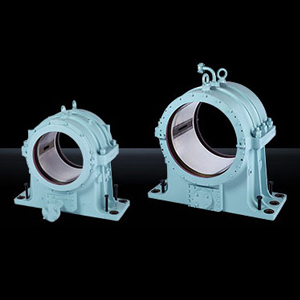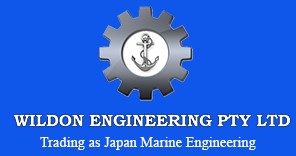Kemel Shaft Bearings: Differences between Self Lubricating System and Forced Lubricating System
Blog | June 30th, 2017 
Heavy-duty shaft bearings are durable and dependable mechanisms. Unfortunately, even a high-performing piece of equipment simply won’t last long if it’s starved of its lubricating agent. Kemel shaft bearings deal with that shortcoming by using a familiar engineering approach. Basically, instead of hitting the problem head on, the Kemel solution adopts a divide and conquer strategy. Split into self-lubricating and forced lubricating systems, let’s check out these two intermediate shaft solutions.
Forced Lubrication Systems
The heavy-gauge bearing cradles a wide bore drive shaft. Out on the open sea, there’s no time for stoppages and constant maintenance, so a maintenance-free architecture is recruited. Instead of a grease-packed engine housing and a lubrication nipple, the oil is pressurised and pumped through a lubrication line, into the oil cut ring, and distributed throughout the bearing surface. A return line acts as the fluid outlet, a place where the hot oil exits, passes through a recycling assembly, and is returned to the lubricant reservoir.
Self-Lubricating Systems
No additional lubricants are conscripted into service on this occasion. The advantage of this alternative heat mitigation architecture is the conscription of a cooling water line. Again, there’s an oil line in the fluid feed network, but this line, unlike the forced lubrication oil line, is not pressurised. Instead, low-pressure lube functions solely as a surface sliding facilitator while the added water line takes over as the system coolant. An extended oil feed prime mover is not required in the self-lubricating mechanism, so no powerful pumps are required to get the oil to the bearing’s inner workings. That feature naturally equals fewer parts, so there’s less chance of an equipment malfunction.
Featuring Chemically Inert Lubricants
In this day and age, there’s so much seagoing traffic in our shipping lanes that a small product flaw would equal a potentially massive environmental issue. Kemel shaft bearings negate this drawback by employing biodegradable lubricants. The bearing lubricating compounds function efficiently as shaft friction attenuators but don’t break down into a toxic sludge. Neither will the lubricating agent decompose when corrosive saltwater enters the system.
Proposed as a marine engineer’s all-encompassing shaft bearing solution, the two lubricating architectures use their own unique mechanisms to dismiss shaft-attenuating kinetic effects. On the one hand, the forced lubricating system forces a pressurised oil into and out of the mating surfaces of the bearing. Meanwhile, the self-lubricating solution reduces the parts count, ejects the oil pump, and opts instead for a low-pressure oil supply, plus a water coolant line.
Optimized by NetwizardSEO.com.au
Recent Posts
- Yanmar Diesel Generators: Planned vs Predictive Maintenance Strategies for Remote Operations
- Mareflex SOLAS Marine Tapes: Safety Applications on Marine Vessels
- Yanmar Propulsion Systems: FPP vs CPP Propellers for 6EY and 6N Series Fuel Efficiency
- Mitsubishi K.K. Purifier Separator: The Key to Cleaner Fuel and Smoother Operations
- Kemel Air Seal Retrofits: Leak-Free Stern Tube Seals and Reduced Lube-Oil Risk
- Yanmar Auxiliary Generators: Sizing for Reefers, Hotel Loads, and Dynamic Positioning Systems
- Water Lubricated Stern Tube Bearing (EVR): Proven Technology for Smooth and Quiet Operations
- Marine Spare Parts Australia: Genuine Components for All Vessel Types
- Yanmar Diesel Generators – Powering Remote and Off-Grid Operations
- Authorised YANMAR Parts Supplier in Australia – Genuine Components Guaranteed
